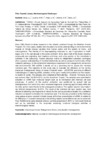Por favor, use este identificador para citar o enlazar este ítem:
http://www.alice.cnptia.embrapa.br/alice/handle/doc/1037800Registro completo de metadatos
| Campo DC | Valor | Lengua/Idioma |
|---|---|---|
| dc.contributor.author | SILVA, L. J. | pt_BR |
| dc.contributor.author | DUARTE, A. W. F. | pt_BR |
| dc.contributor.author | ROSA, L. H. | pt_BR |
| dc.contributor.author | OLIVEIRA, V. M. | pt_BR |
| dc.contributor.author | MELO, I. S. de | pt_BR |
| dc.date.accessioned | 2016-02-22T13:08:13Z | - |
| dc.date.available | 2016-02-22T13:08:13Z | - |
| dc.date.created | 2016-02-19 | pt_BR |
| dc.date.issued | 2015 | pt_BR |
| dc.identifier.citation | In: CONGRESSO BRASILEIRO DE MICROBIOLOGIA, 28., Florianópolis. Anais... Florianópolis: Sociedade Brasileira de Microbiologia, 2015. Ref. 0676-1. | pt_BR |
| dc.identifier.uri | http://www.alice.cnptia.embrapa.br/alice/handle/doc/1037800 | pt_BR |
| dc.description | Abstract: Since 1983, Brazil conducts researchs in the Antartic continent through the Brazilian Antartic Program. For many years, studies were focused only to the understanding of the environmental impacts of climate change resulting from human action and the system of micro.- and macrorganisms. The interest of the bioprospecting molecules for use in agriculture or health began only in the last decade in the same continent. Since about half of the known bioactive compounds are originating from bacteria and fungi, and a tiny portion of the microbiota is cultivable in the Laboratory. Recent advances mainly to independent cultivation techniques allow a greater understanding of microbial biodiversity as well as access to functionality of their metabolic pathways. In this context the heterologous expression from metagenomic clones from total environmental DNA (eDNA) it stands out as a promising tool to access the microbial functional part. The objective of this study was to evaluate the efficiency of the cloning procedure (metagenomic library of clones in fosmid vector - pCC2FOS) according to different methodologies of obtaining eDNA, selection of the gene inserts and conditions for the reaction for ligation to vector. The samples were collected at Admiralty Bay - Antarctic Peninsula, during last summer (Nov/Feb 2014-2015.) by the MycoAntar Project. The samples were submitted to extraction of eDNA high molecular weight such as to mechanical and chemical cell lysis procedures. A portion of the product extraction was partitioned by pulsed field gel electrophoresis from which they were recovered fragments containing approximately 40Kb and the other portion went directly to the subsequent procedure. The ligation reaction was made in two different temperatures 16-25°C. The result of the chemical cell lysis reaction was more efficient at obtaining size fragments of interest for the cloning procedure despite the quantitative reduction compared to extraction by mechanical lysis. The recovery procedure of the inserts gel using gelase enzyme resulted in drastic losses at the final concentration of eDNA. In relation to the difference in incubation temperature the binding reaction some differences can be observed. Thus 15,000 clones were obtained and are currently preserved at -80°C for next experiments as well as be submitted to the enzymatic screening functional biological activities of biotechnological interest. | pt_BR |
| dc.language.iso | eng | eng |
| dc.rights | openAccess | eng |
| dc.subject | Antarctic peninsula | pt_BR |
| dc.subject | Metagenomic library | pt_BR |
| dc.subject | Unculturable microrganisms | pt_BR |
| dc.title | Fosmid library: methodological challenges. | pt_BR |
| dc.type | Resumo em anais e proceedings | pt_BR |
| dc.date.updated | 2016-02-22T13:08:13Z | pt_BR |
| riaa.ainfo.id | 1037800 | pt_BR |
| riaa.ainfo.lastupdate | 2016-02-19 | pt_BR |
| dc.contributor.institution | L. J. SILVA, ESALQ/USP; A. W. F. DUARTE, USP; L. H. ROSA, UFMG; V. M. OLIVEIRA, CPQBA/Unicamp. | pt_BR |
| Aparece en las colecciones: | Resumo em anais de congresso (CNPMA)  | |
Ficheros en este ítem:
| Fichero | Descripción | Tamaño | Formato | |
|---|---|---|---|---|
| 2015RA008.pdf | 149,92 kB | Adobe PDF |  Visualizar/Abrir |









